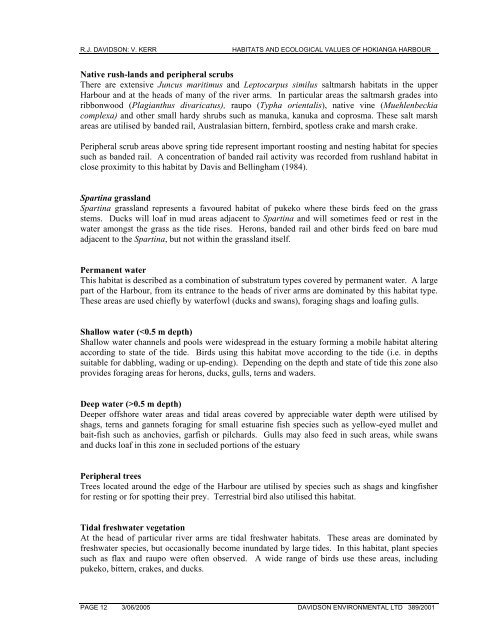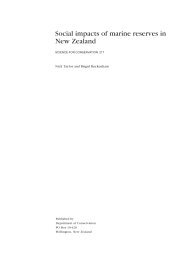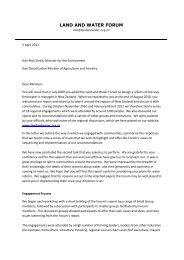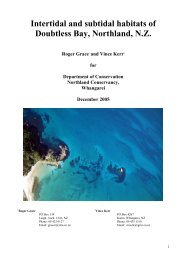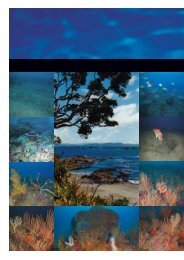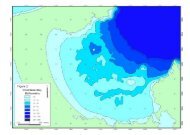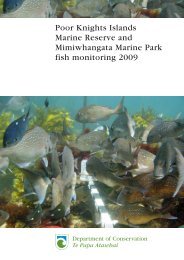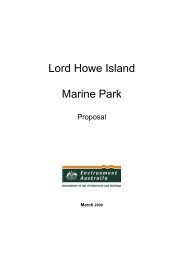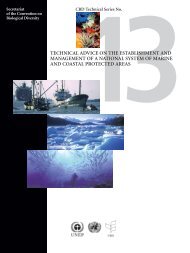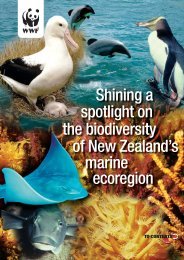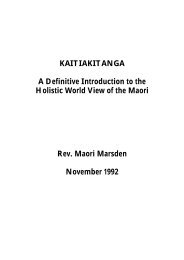Habitats and Ecological Values of the Hokianga ... - MarineNZ.org.nz
Habitats and Ecological Values of the Hokianga ... - MarineNZ.org.nz
Habitats and Ecological Values of the Hokianga ... - MarineNZ.org.nz
You also want an ePaper? Increase the reach of your titles
YUMPU automatically turns print PDFs into web optimized ePapers that Google loves.
R.J. DAVIDSON: V. KERR<br />
HABITATS AND ECOLOGICAL VALUES OF HOKIANGA HARBOUR<br />
Native rush-l<strong>and</strong>s <strong>and</strong> peripheral scrubs<br />
There are extensive Juncus maritimus <strong>and</strong> Leptocarpus similus saltmarsh habitats in <strong>the</strong> upper<br />
Harbour <strong>and</strong> at <strong>the</strong> heads <strong>of</strong> many <strong>of</strong> <strong>the</strong> river arms. In particular areas <strong>the</strong> saltmarsh grades into<br />
ribbonwood (Plagianthus divaricatus), raupo (Typha orientalis), native vine (Muehlenbeckia<br />
complexa) <strong>and</strong> o<strong>the</strong>r small hardy shrubs such as manuka, kanuka <strong>and</strong> coprosma. These salt marsh<br />
areas are utilised by b<strong>and</strong>ed rail, Australasian bittern, fernbird, spotless crake <strong>and</strong> marsh crake.<br />
Peripheral scrub areas above spring tide represent important roosting <strong>and</strong> nesting habitat for species<br />
such as b<strong>and</strong>ed rail. A concentration <strong>of</strong> b<strong>and</strong>ed rail activity was recorded from rushl<strong>and</strong> habitat in<br />
close proximity to this habitat by Davis <strong>and</strong> Bellingham (1984).<br />
Spartina grassl<strong>and</strong><br />
Spartina grassl<strong>and</strong> represents a favoured habitat <strong>of</strong> pukeko where <strong>the</strong>se birds feed on <strong>the</strong> grass<br />
stems. Ducks will loaf in mud areas adjacent to Spartina <strong>and</strong> will sometimes feed or rest in <strong>the</strong><br />
water amongst <strong>the</strong> grass as <strong>the</strong> tide rises. Herons, b<strong>and</strong>ed rail <strong>and</strong> o<strong>the</strong>r birds feed on bare mud<br />
adjacent to <strong>the</strong> Spartina, but not within <strong>the</strong> grassl<strong>and</strong> itself.<br />
Permanent water<br />
This habitat is described as a combination <strong>of</strong> substratum types covered by permanent water. A large<br />
part <strong>of</strong> <strong>the</strong> Harbour, from its entrance to <strong>the</strong> heads <strong>of</strong> river arms are dominated by this habitat type.<br />
These areas are used chiefly by waterfowl (ducks <strong>and</strong> swans), foraging shags <strong>and</strong> loafing gulls.<br />
Shallow water (0.5 m depth)<br />
Deeper <strong>of</strong>fshore water areas <strong>and</strong> tidal areas covered by appreciable water depth were utilised by<br />
shags, terns <strong>and</strong> gannets foraging for small estuarine fish species such as yellow-eyed mullet <strong>and</strong><br />
bait-fish such as anchovies, garfish or pilchards. Gulls may also feed in such areas, while swans<br />
<strong>and</strong> ducks loaf in this zone in secluded portions <strong>of</strong> <strong>the</strong> estuary<br />
Peripheral trees<br />
Trees located around <strong>the</strong> edge <strong>of</strong> <strong>the</strong> Harbour are utilised by species such as shags <strong>and</strong> kingfisher<br />
for resting or for spotting <strong>the</strong>ir prey. Terrestrial bird also utilised this habitat.<br />
Tidal freshwater vegetation<br />
At <strong>the</strong> head <strong>of</strong> particular river arms are tidal freshwater habitats. These areas are dominated by<br />
freshwater species, but occasionally become inundated by large tides. In this habitat, plant species<br />
such as flax <strong>and</strong> raupo were <strong>of</strong>ten observed. A wide range <strong>of</strong> birds use <strong>the</strong>se areas, including<br />
pukeko, bittern, crakes, <strong>and</strong> ducks.<br />
PAGE 12 3/06/2005 DAVIDSON ENVIRONMENTAL LTD 389/2001


